Intel’s Tiger Lake 11th Gen Core i7-1185G7 Review and Deep Dive: Baskin’ for the Exotic
by Dr. Ian Cutress & Andrei Frumusanu on September 17, 2020 9:35 AM EST- Posted in
- CPUs
- Intel
- 10nm
- Tiger Lake
- Xe-LP
- Willow Cove
- SuperFin
- 11th Gen
- i7-1185G7
- Tiger King
CPU Performance: Office and Web
Our previous set of ‘office’ benchmarks have often been a mix of science and synthetics, so this time we wanted to keep our office section purely on real world performance.
Agisoft Photoscan 1.3.3: link
Photoscan stays in our benchmark suite from the previous benchmark scripts, but is updated to the 1.3.3 Pro version. As this benchmark has evolved, features such as Speed Shift or XFR on the latest processors come into play as it has many segments in a variable threaded workload.
The concept of Photoscan is about translating many 2D images into a 3D model - so the more detailed the images, and the more you have, the better the final 3D model in both spatial accuracy and texturing accuracy. The algorithm has four stages, with some parts of the stages being single-threaded and others multi-threaded, along with some cache/memory dependency in there as well. For some of the more variable threaded workload, features such as Speed Shift and XFR will be able to take advantage of CPU stalls or downtime, giving sizeable speedups on newer microarchitectures.
For the update to version 1.3.3, the Agisoft software now supports command line operation. Agisoft provided us with a set of new images for this version of the test, and a python script to run it. We’ve modified the script slightly by changing some quality settings for the sake of the benchmark suite length, as well as adjusting how the final timing data is recorded. The python script dumps the results file in the format of our choosing. For our test we obtain the time for each stage of the benchmark, as well as the overall time.
The final result is a table that looks like this:
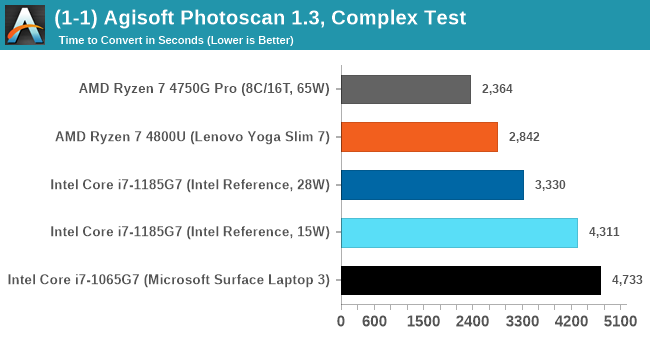
As explained in the power tests, the 4800U with double the cores wins out here, and due to the vector pressure also wins on power efficiency. There’s still a sizeable uplift from Ice Lake to Tiger Lake at 15 W, although 28 W is needed to get something sizeable.
Mozilla Kraken 1.1
Kraken is a 2010 benchmark from Mozilla and does a series of JavaScript tests. These tests are a little more involved than previous tests, looking at artificial intelligence, audio manipulation, image manipulation, json parsing, and cryptographic functions. The benchmark starts with an initial download of data for the audio and imaging, and then runs through 10 times giving a timed result.
Automation involves loading the direct webpage where the test is run and putting it through. All CPUs finish the test in under a couple of minutes, so we put that as the end point and copy the page contents into the clipboard before parsing the result. Each run of the test on most CPUs takes from half-a-second to a few seconds.
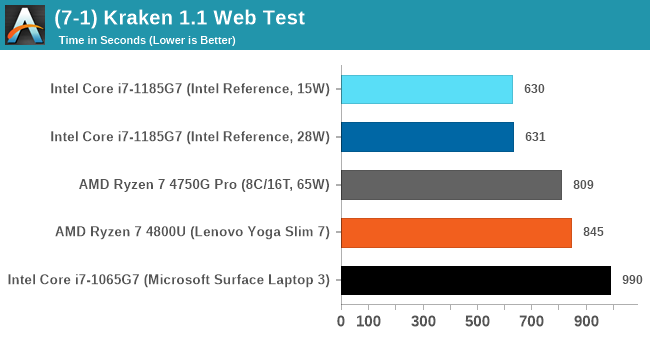
Both the Tiger Lake results are very fast, not showing much difference between the power modes. Intel pushes ahead of AMD here, and ultimately a sizable jump over Ice Lake.
Google Octane 2.0
Our second test is also JavaScript based, but uses a lot more variation of newer JS techniques, such as object-oriented programming, kernel simulation, object creation/destruction, garbage collection, array manipulations, compiler latency and code execution.
Octane was developed after the discontinuation of other tests, with the goal of being more web-like than previous tests. It has been a popular benchmark, making it an obvious target for optimizations in the JavaScript engines. Ultimately it was retired in early 2017 due to this, although it is still widely used as a tool to determine general CPU performance in a number of web tasks.
Octane’s automation is a little different than the others: there is no direct website to go to in order to run the benchmark. The benchmark page is opened, but the user has to navigate to the ‘start’ button or open the console and initiate the JavaScript required to run the test. The test also does not show an obvious end-point, but luckily does try and aim for a fixed time for each processor. This is similar to some of our other tests, that loop around a fixed time before ending. Unfortunately this doesn’t work if the first loop goes beyond that fixed time, as the loop still has to finish. For Octane, we have set it to 75 seconds per run, and we loop the whole test four times.
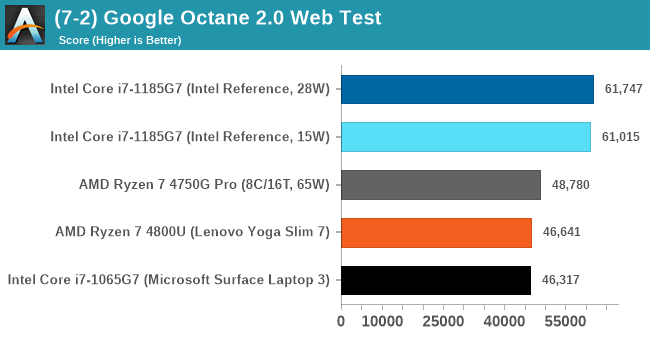
The Tiger Lake system reaches new records in Optane. If there’s anything this system is fast at, it is web workloads.
Speedometer 2: JavaScript Frameworks
Our newest web test is Speedometer 2, which is a test over a series of JavaScript frameworks to do three simple things: built a list, enable each item in the list, and remove the list. All the frameworks implement the same visual cues, but obviously apply them from different coding angles.
Our test goes through the list of frameworks, and produces a final score indicative of ‘rpm’, one of the benchmarks internal metrics. Rather than use the main interface, we go to the admin interface through the about page and manage the results there. It involves saving the webpage when the test is complete and parsing the final result.
We repeat over the benchmark for a dozen loops, taking the average of the last five.
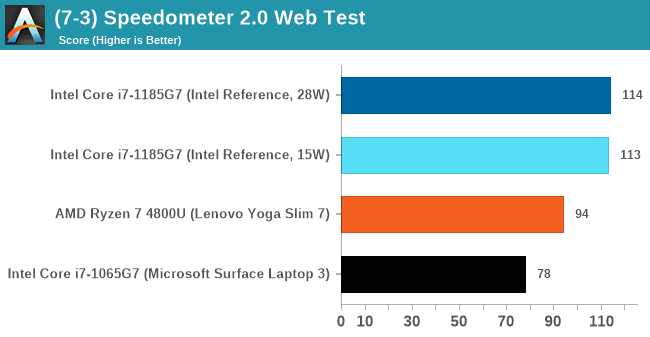
Again, another good win for Tiger Lake.


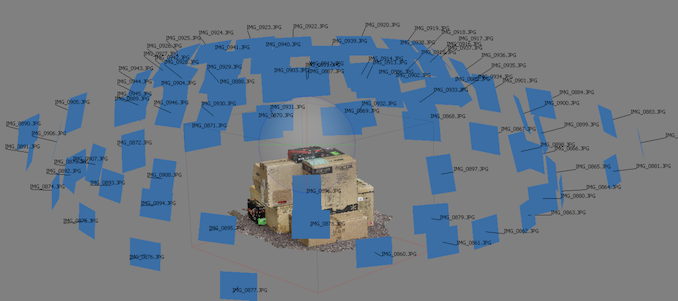
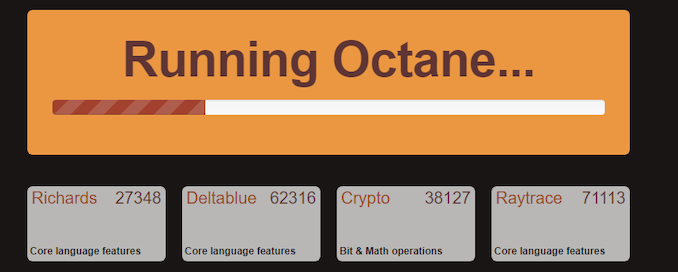
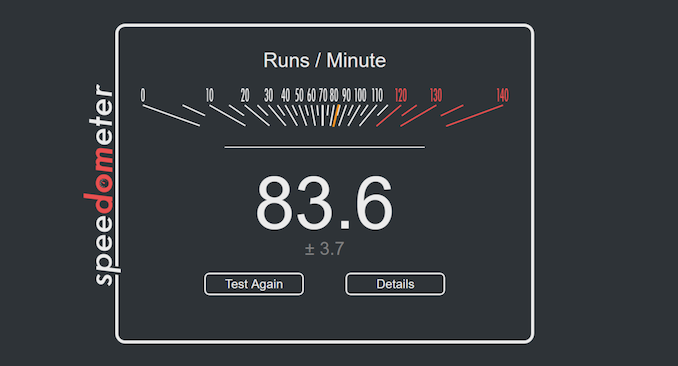








253 Comments
View All Comments
JayNor - Thursday, September 17, 2020 - link
vs Ice Lake the new TGL architecture doubles the bandwidth of the ring bus, adds pcie4, lpddr5, thunderbolt4 and a much superior GPU ... When will AMD catch up? They still need to add avx512, dlboost, integrate wifi6 and now they are further behind. Or do they just add two more cores and declare it even since they can win at cinebench?RSAUser - Thursday, September 17, 2020 - link
PCIe 4 will be next gen, and for current it doesn't really matter, pretty much no consumer SSD that can max it, and GPU is questionable.LPDDR5 should be 2022 with their next gen, which also includes PCIe5 by then.
AV512 doesn't matter, not something you run on a laptop, DLBoost is Intel trademarked, there are other ML libraries that AMD uses, and you're not really running ML training on a laptop CPU, you'd use the GPU.
The ring bus piece is an architecture difference, not sure why you're mentioning it? AMD's CCX design is better, Intel will be moving in that direction.
In regards to integrated WiFi 6/802.11ax, that's a separate module added to the mobo, AMD is not a communication tech company.
JayNor - Saturday, September 19, 2020 - link
Intel integrates the Wifi6 high speed digital components into the PCH chiplet in the same package with the cores on the laptop chips.They build a separate wifi6 chip that OEMs can use with the AMD chips.
JayNor - Saturday, September 19, 2020 - link
Intel's ring bus wins..."We can also see that, even in the 15W configuration, Tiger Lake's dual ring bus delivers slightly more throughput than the 4800U's Infinity Fabric, and has 30% more throughput at 28W with dynamic tuning."
https://www.tomshardware.com/features/intel-11th-g...
Rudde - Saturday, September 19, 2020 - link
You mean Intel caught up with AMD? Intel had a little over half the throughput of Renoir, when Renoir came out. Now Intel has caught up with AMD with Tiger Lake. AMD will likely pull ahead with Cezanne, continuing the back and forth.Spunjji - Saturday, September 19, 2020 - link
Wow, parity at 15W and a win at nearly twice the TDP. Such wins.Seriously, why do you need to pathologically overstate their achievements?
MetaCube - Friday, October 23, 2020 - link
"LPDDR5 should be 2022 with their next gen, which also includes PCIe5 by then." lmaoTheinsanegamerN - Thursday, September 17, 2020 - link
Maybe you dont care about having a better iGPU, but clearly its a selling point.huangcjz - Thursday, September 17, 2020 - link
I care about the integrated GPU. I only buy MacBooks, so AMD isn't a choice. I can't afford £2,400 for the 16" MacBook Pro with discrete graphics.playtech1 - Friday, September 18, 2020 - link
I've got some bad news for you... chances of Apple releasing a Tiger Lake MacBook looks very very slim